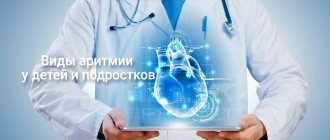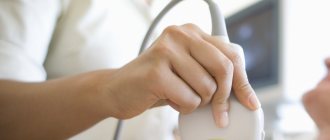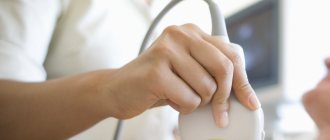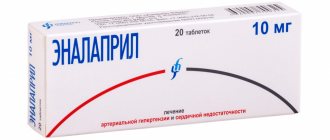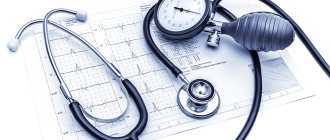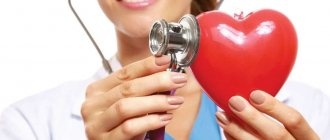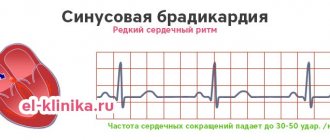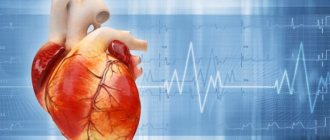Our expert - Head of the Department of Surgical Treatment of Rhythm Disorders and Electrocardiostimulation No. 55 of the State Clinical Hospital named after. Botkin Igor Mayorov.
The beautiful word “arrhythmia,” which became widely known thanks to the famous Russian film about the hard everyday life of an ambulance doctor, denotes a pathology in which the heart rhythm differs from the normal sinus rhythm. As a result, the contractile activity of our motor is significantly impaired, which, in turn, can lead to dangerous complications.
Resulting
Why does the heart, which for the time being had been beating a clear rhythm, suddenly begin to lose track of it? This could be due to many circumstances:
- congenital or acquired heart disease;
- arterial hypertension;
Article on the topicHalfway to a stroke? Dispelling the main myths about hypertension
- electrolyte imbalance (deficiency or excess of potassium, calcium, magnesium in the body);
- hormonal imbalances (therefore, in menopausal women, the risk of arrhythmia increases);
- taking certain medications (diuretics and sympathomimetics, for example);
- concomitant diseases (thyroid pathologies, in particular);
- bad habits (smoking, alcohol, drug addiction).
First aid
The attack begins suddenly, so you need to know how to restore the heart rhythm. Before the ambulance arrives, assistance must be provided. It is important to take effective measures:
- The patient needs to sit more comfortably, preferably placing a pillow under his back. If this happened on the street, then you can sit him on a bench, on the grass.
- Fresh air is needed, so you need to open the window. It is advisable to remove excess clothing that presses or interferes with normal breathing.
- The following actions also help: you should hold your breath for 14-16 seconds and then cough.
- You can induce vomiting by pressing on the root of the tongue. This makes the situation easier.
- Eat a piece of stale bread.
- You need to apply a wet cold cloth to your face or lower your face into a container of cold water for a few seconds.
- Manual therapy techniques are suitable. It is necessary to press on the eyelids every few seconds.
- For chest pain, Nitroglycerin is used.
- Acupressure is used. To do this, for 2 minutes you need to press your thumb on a point located between the thumb and the wrist of the other hand.
Often such procedures allow you to get rid of unpleasant symptoms. How else can you restore your heart rhythm? For this they use Valocordin, Corvalol, and Valerian. Beta-blockers are recognized as effective - “Anaprilin”, “Concor”, “Egilok”.
The doctor needs to be told about your blood pressure and pulse readings over the past few days. It is also important to mention the probable factors that could lead to this - alcohol, stress, medications. If your pulse is low, you should tilt your head back to ensure a better flow of oxygen. In case of fainting, indirect cardiac massage or artificial respiration is effective.
You don't want peace
Many are sure that any increased heartbeat can be considered an arrhythmia. This is wrong. A rapid pulse is also possible with a completely healthy heart - for example, the heart rate always increases during emotional or physical stress. Therefore, to diagnose arrhythmia, you need to contact a cardiologist. In addition, home blood pressure monitors equipped with an arrhythmia indicator can help identify this pathology.
If a person has not yet been diagnosed, but suddenly he feels any unusual sensations or anxiety anywhere in the body, the first thing to do is count the pulse. In case of interruptions, rare or frequent heart rhythm, which is accompanied by any discomfort, you need to call an ambulance. At the hospital, an electrocardiogram will be taken to document heart rhythm disturbances, and the doctor will assess the risks of complications.
Heartfelt enemies. What to do to protect yourself from a heart attack? More details
About arrhythmia
Even when a person with arrhythmia feels well, he needs treatment. This should not be left to chance; attacks of arrhythmia must be alleviated. If this fails, then emergency medical care is needed.
The norm is 50-100 beats/min. A decrease in the number of beats is called bradycardia, and an increase in the number of beats is called tachycardia. If additional beats occur between normal heartbeats, this is a symptom of arrhythmia. These symptoms may be felt by the patient, but there may be no signs.
Arrhythmias are:
- Malignant. They are life-threatening, they impair blood flow, and there is a lack of oxygen in the brain. Blood pressure also decreases and chest pain is felt.
- Benign. They are not dangerous and therefore do not require serious treatment.
If the disease is not treated, serious problems may occur, such as a heart attack. A person needs emergency medical care, otherwise, in its absence, irreparable consequences may occur.
Insidious and dangerous
Arrhythmia is divided into two large groups: tachyarrhythmia - with a rapid heartbeat, and bradyarrhythmia - with a rare pulse. In addition, they are divided into supraventricular and ventricular (depending on what part of the heart they originated in). There is another classification: arrhythmia can be paroxysmal (paroxysmal) and constant (chronic), in which atrial fibrillation persists for years.
And finally, extrasystolic arrhythmia is isolated - premature contraction from the atria or ventricles of the heart.
How dangerous a particular arrhythmia is depends on its type. There are types that are completely harmless and do not lead to significant consequences, while others can even threaten life: for example, lead to the development of heart failure, which is expressed in a decrease in exercise tolerance. In addition, with arrhythmia, there is a high risk of blood clots forming in the heart, which can travel through the vessels and clog them, creating the threat of a heart attack or stroke. Arrhythmia often contributes to thromboembolism (blockage) of peripheral arteries. Against the background of rhythm disturbances associated with a rare pulse, a short-term cardiac arrest may occur, stopping blood circulation and leading to loss of consciousness.
The insidiousness of arrhythmia is that it can be asymptomatic. Therefore, even if you feel well, an irregular rhythm detected by a home blood pressure monitor is a good reason to consult a cardiologist. The doctor will assess the patient’s general condition and perform instrumental diagnostic methods - an electrocardiogram (ECG) or Holter monitoring.
Medicinal plants: 35 recipes for heart health Read more
Causes of heart rhythm disturbances
Let's understand the question of what arrhythmia is. Doctors tend to use this term to refer to any disturbances in the heart rate. This organ may not function properly for two reasons: either changes have occurred in the very structure of the heart muscle, or deviations from the norm are associated with inorganic factors affecting the function of the “pump.”
Do not immediately panic at the slightest change in heart rate. Absolutely healthy people can also be susceptible to spontaneous manifestations of arrhythmia. This condition usually occurs during physical overload, stress, or even during a cold. Although it is dangerous to underestimate the first symptoms: sometimes they indicate an approaching heart attack.
If disruptions in the functioning of the heart were noticed during an examination by a doctor, changes in rhythm may indicate heart failure, coronary artery disease, heart disease, myocarditis, etc. Then the specialist will prescribe the correct treatment and strict monitoring of your health.
But if the doctor does not find cardiac pathologies, the examination should be continued in other directions:
- get checked for diabetes and other endocrine diseases;
- check the balance of magnesium, potassium, sodium;
- find out if there are any problems with blood pressure.
The cause of atrial fibrillation can also be certain pharmacological drugs that a person used before. It also often occurs due to strong emotional experiences, oncology, menopause and head injuries.
ethnoscience
Is it possible to restore heart rhythm using traditional medicine? They are often considered effective because they eliminate discomfort in a short time:
- Mint. The plant is drunk both during an attack and daily on an empty stomach. Peppermint (3 tablespoons) is poured with boiling water and let the product infuse. During an attack, you can drink fresh mint tea.
- Valerian, motherwort, anise, yarrow. It is advisable to use this collection for those who have an increased heart rate. You need to take 1 tbsp. l. each plant and place in a thermos. 2 liters of boiling water is poured there. You need to drink 0.5 cups before meals - 3 times a day. Regular use makes the heartbeat rhythm healthy.
- Heather. The plant has an excellent effect on the functioning of the heart, calms the nervous system, and relieves spasms of the heart muscle. The decoction is consumed throughout the day instead of tea, and heather infused with alcohol should be used as an emergency treatment measure during an attack.
- Sesame oil, lemon, walnuts. Place chopped lemons in boiling water. You should let it cook for a while. Then add chopped walnuts and sesame oil. Add 3 lemons, oil (9 tbsp) and walnuts (1 cup) to water (100 l). Can be sweetened with honey. The mass should stand in a warm place, and then it is strained. The resulting product is drunk 1 tbsp. l. before eating.
- Apricot kernels, lemon and honey. You need to grind lemons (0.5 kg), apricot kernels (a handful) through a meat grinder. You need to add honey (1/2 cup). The product is used before bedtime, 1 tbsp. l. It restores the functioning of the heart.
- Calendula. The plant can restore heart rhythm. For frequent attacks, you should have a prepared decoction of calendula flowers in the refrigerator. If there are no attacks, you need to drink ½ glass of the decoction every day on an empty stomach.
Traditional medicine will be useful if approved by a doctor. But first a diagnosis is made. You should not self-medicate as this may make the situation worse.
What to do if your heart rate suddenly increases
When the pulse quickens for no apparent reason, it causes fear and anxiety. The main thing in such a situation is not to be nervous and try to determine what is happening in the body. If tachycardia remains the only symptom, you should breathe deeply and remain calm. Warning signs may include pain in the heart area that radiates to the neck or arm, as well as numbness and trembling of the limbs. In most cases, they are absent, and you can calm your heartbeat at home quickly, thanks to several useful methods.
Medicines
In many home medicine cabinets you can find drugs to reduce heart rate. They are available without a doctor's prescription and will help you quickly restore your performance. However, before taking them, it is important to find out the cause of this symptom, since different groups of drugs have different compositions and are indicated for tachycardia of different origins. So, the doctor may recommend the following medications:
- Valocordin, Corvalol - drugs based on phenobarbital and plant extracts, available in the form of drops that need to be diluted in water;
- valerian officinalis - comes in the form of drops and tablets, it helps well with tachycardia caused by nervous tension;
- rosehip or hawthorn fruits, motherwort root - raw materials for the preparation of soothing decoctions, useful for calming the heartbeat;
- if necessary, medications to replenish potassium or magnesium deficiency (Asparkam, Panangin).
IMPORTANT! After taking medications, you should avoid physical activity. It is better to spend this day in a calm environment, avoiding stress and nervous tension.
Corvalol or its analogues should be present in any home medicine cabinet
Cold water
Another way to lower your heart rate is to sharply lower your temperature. The easiest way to do this is with cold water. It is important that the body reacts most quickly to cooling the skin of the face, so it is not necessary to douse yourself completely. It is enough to immerse your face in a container of cold water or use a spray bottle. At home, you can also take an ice cube and wipe your face and temples with it. At the same time, you should monitor your breathing - take deep breaths and exhales.
Gymnastics
You can quickly calm your heartbeat even if you don’t have a first aid kit with medications on hand. One of the simplest and most accessible methods is breathing exercises. Its effectiveness is explained by the basic principles of the cardiovascular system. The pulse speeds up when cells are starved of oxygen and the heart has to pump faster to push out more blood. An increased heart rate leads to increased stress on organs and tissues, which increases the need for oxygen. For this reason, an increase in heart rate is often observed in hot and stuffy rooms.
This circle must be broken in order to normalize the functioning of the heart. The gymnastics are simple and can be performed independently:
- ventilate the room or go outside (in the heat - find the coolest area);
- inhale deeply while raising your arms up - this way a larger volume of oxygen enters the lungs;
- exhale deeply while lowering your arms down.
The exercise is performed slowly, and it is important to focus on breathing. You can also count the number of breathing cycles. It must be repeated until the pulse returns to normal. It is important to understand that if you return to a stuffy, gas-filled room, the attack may recur. For frequent manifestations of tachycardia, it is recommended to frequently ventilate the rooms, as well as install humidifiers and air filters. If the attack cannot be stopped, you should quickly calm the pulse with drugs, and then undergo examination by a doctor.
Breathing exercises also include the prevention of diseases of the cardiovascular system
Valsalva maneuver
This technique is designed specifically to quickly lower your heart rate without taking drugs. Its main goal is to influence the vagus nerve, which is responsible for heart rate. The exercise is performed as follows:
- take a deep breath, while tensing your abdominal muscles;
- pinch your nose with your fingers, close your eyes and mouth;
- in this position, try to exhale the air without relaxing the abdominal muscles.
IMPORTANT! This exercise, like others, is contraindicated in case of acute cardiac dysfunction. Chest pain, numbness of the limbs, dizziness, loss of consciousness - with these symptoms you should not try to reduce your heart rate on your own.
Massage
With the help of massage, you can influence certain areas that are located along the vagus nerve. It belongs to the parasympathetic system and also affects a person’s heart rate. These techniques are simple, but it is important to do them correctly and take your time and not apply too much pressure.
- Massage of the sinocarotid zone. It is located in the neck area, just below the lower jaw. At this point there is a branch of the carotid artery. Use your thumb to press on this point on the left and right sides for 3–5 minutes. This massage simultaneously equalizes heart rate and blood pressure.
- The eyeballs are an area in which a huge number of nerve endings are concentrated. It is enough to close your eyes and gently press them with your fingers for several minutes, and there should be no pain. If necessary, you can open your eyes, slowly look in different directions and repeat the procedure.
You can perform the massage yourself. In this case, you should take a comfortable position and monitor your breathing. Positive changes should be observed within the first 3-10 minutes. If they do not appear, the only way to calm the heart is with medications - your doctor will tell you what to take in each specific case. First aid drugs are Corvalol and Valocordin.
Prevention
What should be done to avoid arrhythmia? In order for the heart rhythm to be normal, it is necessary to change the quality of life. Don't be nervous about little things. It is advisable to replace nervous work with calm work. It is necessary to adjust the diet by removing fatty, fried, high-calorie foods from it. You should not drink coffee and strong tea, you should eat less sweets. It is necessary to play sports, as it trains the heart. But the load should be moderate. It is important to avoid alcohol and smoking, as this negatively affects the functioning of the heart.
There is a special exercise that is necessary for the rhythmic functioning of the heart. You take a deep breath, pinch your mouth and nose, and then exhale. This is done when the ears are stuffy. The exercise is performed several times every day.
What should you keep in your first aid kit?
If a person periodically has attacks, then you need to know how to restore the heart rhythm at home. This will quickly eliminate unpleasant symptoms. In your home medicine cabinet you should have medications that restore heart rhythm:
- "Panagin."
- Hawthorn tincture.
- Tablets "Anaprilin".
- Muscle relaxant – “Seduxen”, “Relanium”.
Before using any product, you should read the instructions for the tablets that restore heart rhythm. During an attack, you should not go to work or exercise. You need a state of peace and comfort.
All sedatives can eliminate arrhythmia or reduce symptoms of the disease. They are taken without a doctor's prescription. These are tinctures, potions and tablets. Products with valerian or motherwort are in demand.
How to restore heart rhythm with atrial fibrillation? Your doctor may prescribe antiarrhythmic drugs that reduce the number of attacks and reduce pain. This is “Quinidine”, “Ri. But these products are toxic. When taking them, it is necessary to monitor the level of potassium and magnesium in the blood, as well as the functioning of the kidneys. With frequent attacks, stabilization of the rhythm can be performed using an electric current discharge.
How to restore heart rhythm at home if you are intolerant of antiarrhythmic drugs? In this case, the doctor prescribes tranquilizers. They are used for rapid restoration of cardiac output, "Grandaxin", "Elenium". The type of drug and dosage must be prescribed by a doctor.
How to restore heart rhythm with other medications? Homeopathic remedies are effective in eliminating the cause of arrhythmia, which reduces the number of attacks and the severity of symptoms. Patients with various ailments should consume honey, apricots, grapes, raspberries, and currants daily. The products are able to saturate tissues with active ions and also reduce the amount of cholesterol.
